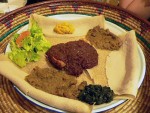A half-year after returning home from a few weeks in North India, I thought it would be a good idea to cook some Indian dishes for friends. Twelve friends, to be exact.
It wasn’t long after I emailed said friends that I began questioning the wisdom of this decision.
Indian food is notoriously difficult for a non-Indian to pull off. Sure, having access to the right spices is half the battle, but in past experiments with an Indian cookbook, I’ve found that the spice ratio often seems off. For all the toasting and grinding of seeds called for, there’s never anywhere near the amount of flavor one expects, certainly nothing like the richness radiating from most Indian-restaurant dishes. (Of course, that might be the excess ghee speaking.) Or else, between the red chile powder and garam masala, I somehow wind up with so much heat that the dish is nearly inedible, even for a spice lover like me.
So why did I think I could have an Indian-food dinner party? While in Udaipur, Scott and I stayed at the friendly Hotel Krishna Niwas, where one of the owners, Sushma Khatri, runs cooking classes on pretty much anything you’d like to learn in Indian cuisine. At our request, she made us one of Rajasthan’s classic dishes, dal baati chorma; we ate it with relish and promptly signed up for a formal class. We wanted to cook some of our favorite dishes from North India: chole bhature, butter chicken, paratha. We ended up making all of those plus dal, chapati, and masala chai. In Sushma’s open kitchen, filled with easy-to-access spice bins and pre-pureed tomatoes, it all seemed so easy—and everything we made together was delicious, especially when eaten on the hotel’s roof, gazing out over Lake Pichola.
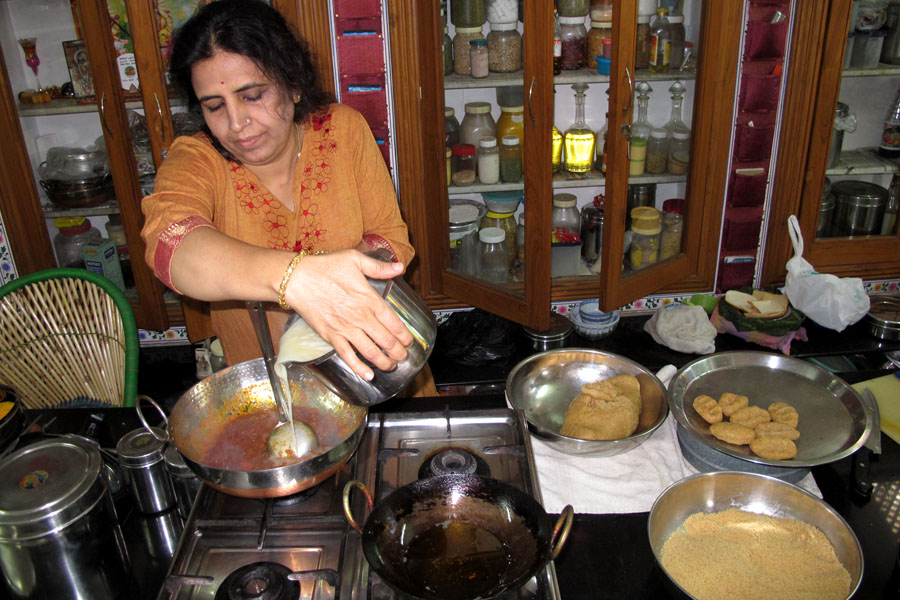
Fast-forward six months to our comparatively cramped kitchen in Queens, plastic spice bags scattered across the counter, pounds of onions and tomatoes sitting on the floor, one burner short of what we really needed—and the two of us, frantically chopping and measuring and hoping everyone would be at least 30 minutes late. The shopping part was easy, at least: We are fortunate to live two blocks from a terrific South Asian grocery store, stocked with all the mango powder and paneer we could ever want, and have a bunch of Indian sweets shops from which to buy dessert (and papri chips, it turned out).
Our menu was sourced directly from our own experiences in India. As appetizers, we chose two of our favorite chaats, or savory street-style snacks, and for the three main courses, we went with curried chickpeas (the chole minus the bhature, or fried bread that usually goes with it), butter paneer masala (like butter chicken, but with paneer, a soft Indian cheese), and baingan ka bharta (mashed eggplant, tomato, and onion). The first two main courses were recipes from Sushma in Udaipur (and dishes we’d eaten all over North India); the third dish I chose because I’d particularly liked the version of it we’d had in Agra. On the side were roti and naan—store- and restaurant-bought, admittedly—and although North India is all about mopping up curries with bread, we thought that fluffy basmati rice should be on the table too. I was tempted to make lassis and chapatis, and maybe some rasmalai for dessert, but thankfully my husband knows when to tell me I’m going too far.
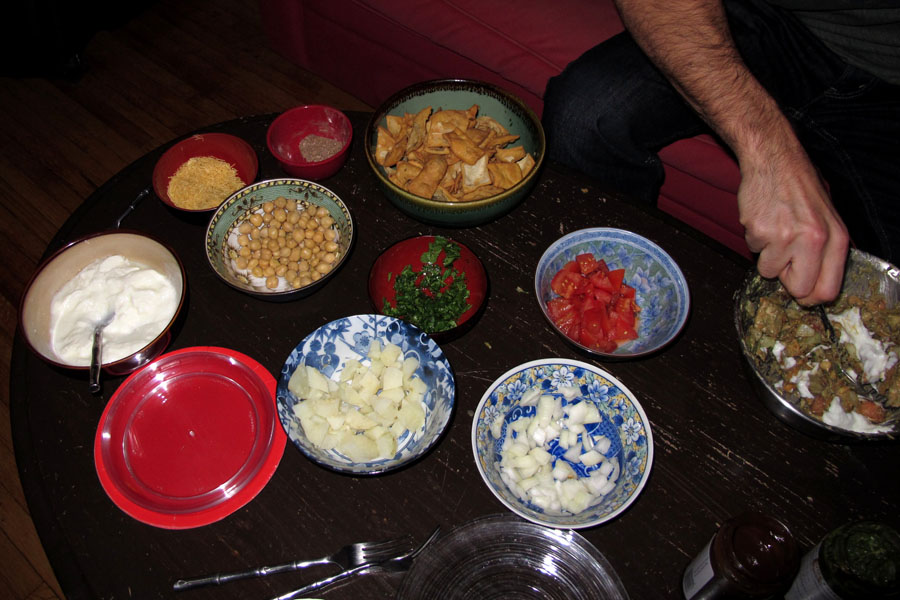
Another thing to be thankful for: Nearly everyone was a bit late (and the two who showed up early were put straight to work), so I had time to finish the main dishes while Scott shook up Kashmir cocktails (see recipe). Then we remembered the appetizers and quickly put out the ingredients for papri chaat (pictured above)—our favorite chaat of them all, a crunchy, spicy, sweet, tangy party in your mouth—as well as a huge bowl of fruit chaat, essentially a fruit salad with an Indian dressing (I based ours on this recipe from Manjula’s Kitchen, using banana, apple, mango, cucumber, grapes, and pomegranate seeds—and, yes, you really do need the black salt).
Ultimately, I was astonished: Our friends seemed to like the food! It had flavor and depth without burning anyone’s insides. And though I’d made the chickpea dish before with excellent results (I’ll give that recipe in a future post), I wasn’t too surprised that the two biggest hits of the night were the papri chaat and the butter paneer masala. Once you manage to track down their myriad ingredients, these are two dishes you really can’t go wrong with—even if you’re not plying your guests with mango cocktails and IPAs.
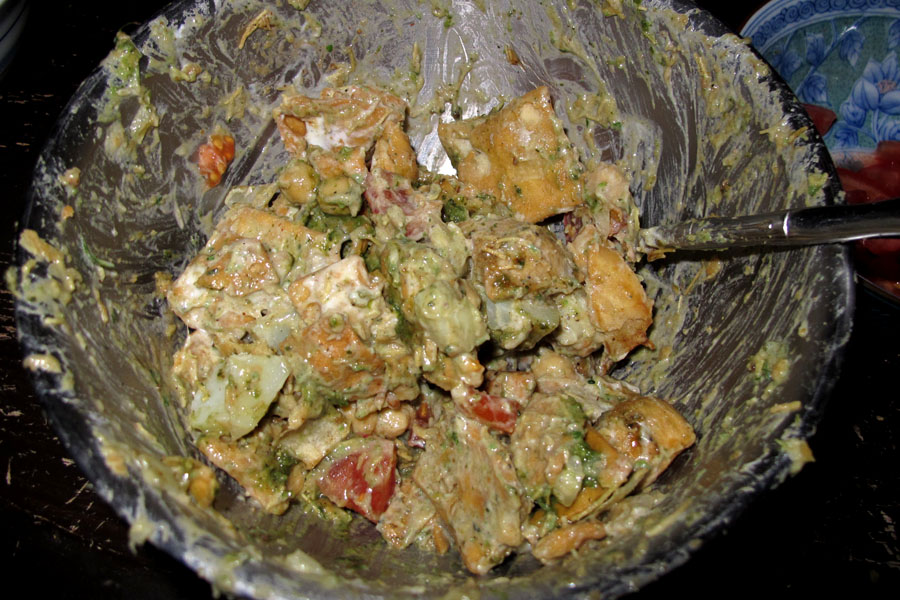
PAPRI CHAAT
(adapted from The ABCD’s of Cooking)
Serves 12
4 cups papri chips
1 12 oz. can chickpeas
2 large potatoes, boiled and chopped
1 32 oz. container yogurt (preferably Indian style, like Desi Natural Dahi)
1 bottle tamarind chutney
1 bottle coriander chutney (we used Swad brand)
1 package sev (fried gram-flour noodles)
1 package chaat masala
1 white or yellow onion, chopped
1 tomato, chopped
Lime juice
Cilantro
Green chilies, minced
We emulated our local chaat shops and made these to order in a stainless-steel bowl, which meant setting all these ingredients out and, working in batches to make two or three servings at a time, mixing them together. Measurements per bowl were pretty inexact, but you can start with a handful of chips and about a tablespoon of everything else (less of the chaat masala and chilies). It’s the kind of dish you make to taste, depending on whether you prefer your chaat dry or wet (use more yogurt), spicy or mild. Rest assured that any way you mix these things together, it’s going to taste good.
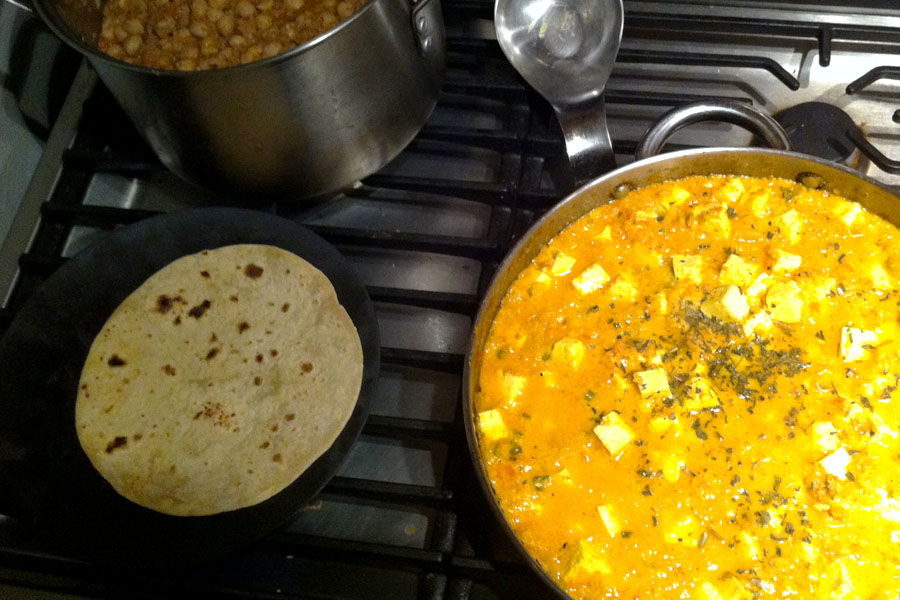
BUTTER PANEER MASALA
(adapted from Sushma Khatri’s cooking class at the Hotel Krishna Niwas, Udaipur, Rajasthan, India)
Serves 12 (we doubled the original recipe, more or less)
6 onions, chopped
2 tsp green chile, chopped
1 tsp. ginger
6 Tbsp. butter
1 tsp. turmeric powder
1 tsp. red chile powder
1 tsp. garam masala
Salt to taste
7 tomatoes, blanched, peeled, and pureed
3 Tbsp. double cream
12 almonds, ground
12 cashews, ground
4 Tbsp. coconut powder
1 lb. paneer, cut into 1-inch slabs (or large cubes)
2 cups milk (we did not double this from original recipe, as 2 cups seemed plenty)
Pinch fenugreek leaves, garam masala
Using a food processor, grind the onion, ginger, and green chile together, and then, in a large pan, cook in butter till light brown. Add turmeric, chile powder, garam masala, and salt; then slowly add tomato puree, a little at a time. Next, stir in cream, ground nuts, and coconut powder; continue to cook over high heat for a few minutes until oil pools around pan edges. Add paneer and milk, lower heat, and add fenugreek leaves and garam masala. Without mixing the last two spices in, cover the pan and simmer for five minutes. At that point, taste the dish—we found we had to add a bit more butter, salt, and fenugreek before it was perfect.










.jpg)
